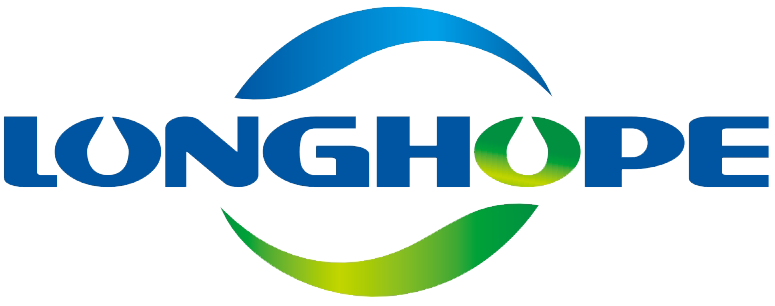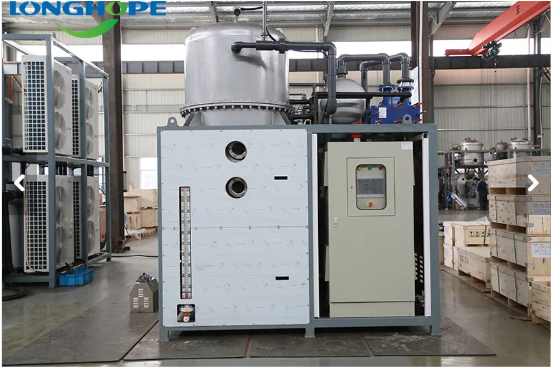หลักการพื้นฐานของ เครื่องระเหยสุญญากาศอุตสาหกรรม
วิธีการทำงานของเครื่องระเหยสุญญากาศภายใต้ความดันที่ลดลง
เครื่องระเหยสุญญากาศทำงานโดยการลดจุดเดือดของน้ำ เพื่อให้น้ำสามารถระเหยได้ที่อุณหภูมิต่ำกว่าปกติมาก ซึ่งหมายความว่าโดยรวมแล้วต้องใช้ความร้อนน้อยลง และช่วยประหยัดค่าใช้จ่ายด้านพลังงาน เทคนิคหลักของเทคโนโลยีนี้คือการสร้างสภาพแวดล้อมสุญญากาศเพื่อลดความดันบรรยากาศ ทำให้น้ำมีพฤติกรรมการระเหยเปลี่ยนไปเมื่อถูกให้ความร้อน โดยทั่วไป ระบบส่วนใหญ่จะใช้ปั๊มจักรกลในการดูดอากาศออกและรักษาสภาวะความดันต่ำไว้ภายในห้องสุญญากาศ สำหรับอุตสาหกรรมที่ต้องการลดต้นทุนและยังคงเป็นมิตรกับสิ่งแวดล้อม การเพิ่มขั้นตอนหลายขั้นตอนเข้าไปในกระบวนการระเหยยังเป็นทางเลือกที่เหมาะสมด้วย แต่ละขั้นตอนจะจับเอาไอระเหยไว้ให้ได้มากขึ้นก่อนที่จะส่งต่อไปยังขั้นตอนถัดไป เพื่อให้แน่ใจว่าพลังงานทุกส่วนถูกนำไปใช้ประโยชน์อย่างมีประสิทธิภาพตลอดกระบวนการผลิต
ส่วนประกอบสำคัญ: ถังต้ม คอนเดนเซอร์ และฮีทเอ็กเชนเจอร์
เครื่องระเหยสุญญากาศอุตสาหกรรมมีส่วนประกอบหลักหลายชิ้น ได้แก่ ถังไอน้ำ (boiler tanks), เครื่องควบแน่น (condensers) และเครื่องแลกเปลี่ยนความร้อน (heat exchangers) ซึ่งทั้งหมดนี้ทำงานร่วมกันเพื่อให้ระบบโดยรวมทำงานได้อย่างเหมาะสม ถังไอน้ำจะสร้างไอน้ำขึ้น เมื่อให้ความร้อนกับของเหลว ซึ่งจะให้พลังงานที่จำเป็นต่อการเกิดการระเหย จากนั้นหน้าที่ของเครื่องควบแน่นก็คือ การทำให้ไอเย็นตัวลงและเปลี่ยนกลับเป็นของเหลว เพื่อช่วยในการกู้คืนน้ำส่วนใหญ่และลดปริมาณน้ำที่สูญเสียไป ส่วนเครื่องแลกเปลี่ยนความร้อนก็มีบทบาทในการถ่ายโอนความร้อนอย่างมีประสิทธิภาพเข้าสู่กระบวนการบำบัดน้ำ ส่วนประกอบเหล่านี้ทำงานประสานกันเพื่อเพิ่มประสิทธิภาพในการทำงานของระบบโดยรวม ทำให้มั่นใจได้ว่ามีการถ่ายโอนพลังงานความร้อนอย่างรวดเร็วและมีประสิทธิภาพในแต่ละขั้นตอนของการทำงาน
ประเภทของ เครื่องระเหยสุญญากาศอุตสาหกรรม (Heat Pump, MVR, and Multi-Effect)
การเลือกตั้งเครื่องระเหยสุญญากาศนั้นขึ้นอยู่กับปริมาณพลังงานที่ใช้เป็นหลัก รวมถึงลักษณะการใช้งานที่ต้องการ แบบจำลองที่ใช้ปั๊มความร้อน (Heat pump) มีจุดเด่นตรงที่สามารถนำพลังงานความร้อนกลับมาใช้ใหม่ ซึ่งช่วยลดค่าไฟฟ้าได้อย่างมีนัยสำคัญ นอกจากนี้ยังมีระบบอัดความร้อนจากไอระเหยกลับ (Mechanical Vapor Recompression หรือ MVR) ที่ก้าวไปอีกขั้น โดยทำงานด้วยการอัดไอระเหยให้รับความร้อนเพิ่มเติม เพื่อให้สามารถกอบกู้พลังงานส่วนใหญ่ที่มิฉะนั้นจะสูญเสียไป วิธีการอื่นคือการใช้เครื่องระเหยแบบหลายผล (multi-effect evaporators) ซึ่งไอน้ำที่เกิดขึ้นในขั้นตอนหนึ่งจะถูกนำไปใช้เพื่อให้ความร้อนในขั้นตอนถัดไปทันที ทำให้ความร้อนที่ได้รับนำมาใช้ซ้ำได้หลายครั้งในกระบวนการผลิต เทคโนโลยีทั้งหมดนี้จะถูกปรับใช้ให้เหมาะสมกับอุตสาหกรรมเฉพาะทาง ขึ้นอยู่กับความต้องการเฉพาะด้านประสิทธิภาพและการควบคุมต้นทุนในกระบวนการระเหยขนาดใหญ่
ประสิทธิภาพพลังงานในกระบวนการบำบัดน้ำเสีย
ลดการใช้พลังงานความร้อนผ่านเทคโนโลยีสุญญากาศ
เทคโนโลยีสุญญากาศมีความสำคัญอย่างมากในการเพิ่มประสิทธิภาพของโรงบำบัดน้ำเสียในการจัดการความร้อน ระบบนี้ช่วยลดการใช้พลังงานในการให้ความร้อนเพิ่มเติม ซึ่งจากการศึกษาบางส่วนชี้ว่าสามารถประหยัดค่าพลังงานได้ราว 30% เมื่อรวมเข้ากับระบบการกู้คืนความร้อนที่ติดตั้งอยู่ใกล้กับเครื่องระเหยสุญญากาศ โรงงานสามารถจับความร้อนที่สูญเปล่าและนำกลับมาใช้ใหม่ได้ ส่งผลให้พลังงานที่ถูกทิ้งลดลงไปอีก สำหรับผู้ที่ดูแลสถานบำบัดน้ำเสีย การตรวจเช็กอุปกรณ์เป็นประจำไม่ใช่เพียงแค่แนวทางปฏิบัติที่ดี แต่เป็นสิ่งจำเป็นอย่างยิ่งหากต้องการตรวจจับจุดที่เงินอาจกำลังไหลหายไปทั้งทางตรงและทางอ้อม การประเมินเหล่านี้จะช่วยให้สามารถแก้ไขปัญหาเล็กๆ ที่อาจส่งผลให้เกิดการสูญเสียประสิทธิภาพและช่วยควบคุมค่าใช้จ่ายในการดำเนินงานให้อยู่ในระดับที่เหมาะสม
กรณีศึกษา: การฟื้นฟ้าน้ำ 90% ในอุตสาหกรรมเภสัชกรรม
ตัวอย่างที่เกิดขึ้นจริงคือบริษัทยาเจ้าใหญ่ที่ได้เห็นผลลัพธ์อันน่าทึ่งหลังติดตั้งเครื่องระเหยสุญญากาศ สามารถกู้คืนน้ำกระบวนการได้ประมาณ 90% ระบบใหม่นี้ทำให้บริษัทอยู่ภายใต้ข้อกำหนดทั้งหมดที่กำหนดไว้ ขณะเดียวกันก็ช่วยลดค่าใช้จ่ายในการกำจัดของเสียลงได้หลายพันต่อเดือน นิตยสารเฉพาะทางในอุตสาหกรรมต่างนำเสนอการติดตั้งลักษณะนี้ เพื่อแสดงให้เห็นว่าบริษัทต่างๆ สามารถประหยัดค่าใช้จ่ายพร้อมทั้งลดผลกระทบต่อสิ่งแวดล้อมไปพร้อมกันได้ เทคโนโลยีการระเหยด้วยสุญญากาศจึงกำลังกลายเป็นทางเลือกอันดับต้นๆ สำหรับผู้ผลิตที่ต้องการปรับกระบวนการทำงานให้เป็นมิตรกับสิ่งแวดล้อม โดยไม่ต้องลงทุนสูงมาก
การประหยัดต้นทุนจากการลดปริมาณการกำจัดและการนำกลับมาใช้ใหม่
การใช้เครื่องปั่นน้ําด้วยลมสูญเสีย จะช่วยประหยัดเงิน เพราะมันทําให้ธุรกิจสามารถนําน้ําไปใช้ใหม่แทนที่จะโยนทิ้ง บริษัทบางแห่งรายงานว่า ลดค่าใช้จ่ายในการบําบัดน้ําเสียลงประมาณ 30% เมื่อพวกเขานําระบบเหล่านี้มาใช้อย่างถูกต้อง ค่าใช้จ่ายในการดําเนินงานที่ต่ํากว่า ทําให้ธุรกิจส่วนใหญ่ ได้เงินลงทุนกลับคืนมาอย่างรวดเร็ว ซึ่งทําให้เครื่องปั๊มหมอกสูบสูบเป็นตัวเลือกที่น่าสนใจสําหรับผู้บริหารที่ระวังงบประมาณ ดูตัวเลขแล้วเห็นว่าหน่วยงานเหล่านี้ก็ลดค่าธรรมเนียมที่เกี่ยวข้องกับกฎหมายสิ่งแวดล้อม นั่นเป็นเหตุผลที่ผู้ผลิตมากขึ้นและมากขึ้น กําลังหันมาหาพวกเขา โดยเฉพาะในช่วงเวลาที่เงินทุกเหรียญมีค่า และความกดดันทางกฎหมายเพิ่มขึ้น
สำหรับแนวทางแก้ไขปัญหาและผลิตภัณฑ์โดยละเอียด กรุณาสำรวจช่วงผลิตภัณฑ์เครื่องระเหยสุญญากาศของเราที่ออกแบบมาเพื่อรองรับการใช้งานในอุตสาหกรรมหลากหลายประเภท พร้อมรับประกันประสิทธิภาพในการบำบัด รวมทั้งเป็นไปตามเป้าหมายด้านพลังงานและแนวทางความยั่งยืน
Applications ในอุตสาหกรรมหลักต่าง ๆ
เภสัชกรรม: การบำบัดน้ำเสียที่ปนเปื้อน API
เครื่องระเหยสุญญากาศเป็นอุปกรณ์ที่จำเป็นสำหรับการจัดการน้ำเสียที่ปนเปื้อนจากกระบวนการผลิตสารออกฤทธิ์ทางเภสัชกรรม (API) ระบบที่กล่าวถึงนี้ช่วยให้บริษัทเภสัชกรรมสามารถปฏิบัติตามมาตรฐานสิ่งแวดล้อมที่เข้มงวด ขณะเดียวกันก็ช่วยลดมลพิษและส่งเสริมแนวทางการผลิตที่เป็นมิตรต่อสิ่งแวดล้อมมากขึ้น การประยุกต์ใช้งานจริงแสดงให้เห็นว่าเทคโนโลยีการระเหยสุญญากาศในปัจจุบันสามารถกำจัดสารปนเปื้อนในน้ำเสียได้ประมาณ 95% โดยประสิทธิภาพเช่นนี้ไม่เพียงแต่ส่งผลดีต่อสิ่งแวดล้อม แต่ยังช่วยให้ผู้ผลิตสามารถควบคุมต้นทุนการจัดการของเสียและประเด็นการปฏิบัติตามข้อกำหนดทางกฎหมายได้ดีขึ้น อีกทั้ง โรงงานหลายแห่งรายงานว่าประสิทธิภาพในการดำเนินงานดีขึ้นควบคู่ไปกับประโยชน์ด้านสิ่งแวดล้อมเมื่อทำการอัปเกรดเป็นระบบระเหยสุญญากาศ
อาหารและเครื่องดื่ม: การจัดการน้ำทิ้งที่มี BOD สูง
เครื่องระเหยสุญญากาศมีบทบาทสำคัญในการจัดการน้ำเสียที่มีค่า BOD สูงในอุตสาหกรรมอาหารและเครื่องดื่ม เมื่อบริษัทลดระดับ BOD ก่อนปล่อยน้ำเสียสู่สิ่งแวดล้อม จะช่วยให้บริษัทดำเนินการได้ตามกฎหมาย และยังช่วยปกป้องระบบนิเวศในพื้นที่ใกล้เคียง โมเดลใหม่ล่าสุดที่มีอยู่ในท้องตลาดสามารถลดค่า BOD ต่ำกว่าข้อกำหนดของหน่วยงานกำกับดูแลได้อย่างมีประสิทธิภาพ ทำให้โรงงานสามารถดำเนินกิจการอย่างยั่งยืน โดยไม่ต้องกังวลเกี่ยวกับค่าปรับอย่างต่อเนื่อง นอกเหนือจากการปฏิบัติตามข้อกำหนดทางกฎหมายแล้ว ระบบเหล่านี้ยังช่วยให้ผู้ผลิตอาหารสามารถมีส่วนร่วมเชิงบวกต่อชุมชนของตนเอง ผ่านการส่งเสริมคุณภาพของแหล่งน้ำและลดผลกระทบจากมลพิษ
การผลิตโลหะ: การรีไซเคิลอิมัลชันและสารหล่อเย็นที่มีน้ำมัน
ในร้านงานโลหะทั่วประเทศ ตัวระเหยสุญญากาศกำลังกลายเป็นทางเลือกอันดับต้นๆ สำหรับการจัดการสารเอมัลชันน้ำมันและสารผสมสารหล่อลื่นที่น่ารำคาญเหล่านั้น แทนที่จะทิ้งทุกอย่างไปเฉยๆ เครื่องจักรเหล่านี้กลับสามารถเปลี่ยนของเสียให้กลายเป็นทรัพยากรที่นำกลับมาใช้ใหม่ได้จริง ผลลัพธ์ที่ได้คือ ค่าใช้จ่ายลดลงสำหรับการกำจัดวัสดุอันตราย และผลกระทบต่อสิ่งแวดล้อมที่ลดน้อยถอยลงอย่างมาก จากตัวเลขที่ผู้ผลิตต่างๆ ให้ข้อมูลไว้ ระบบที่ติดตั้งอย่างเหมาะสมสามารถกู้คืนของเสียจากกระบวนการกลึงที่มีน้ำมันปนอยู่ได้สูงถึงประมาณ 90% ประสิทธิภาพในระดับนี้ หมายความถึงการประหยัดเงินได้จริงในระยะยาว พร้อมทั้งช่วยรักษาสิ่งแวดล้อมของโลกเราไปในตัว ผู้จัดการโรงงานหลายคนที่เราได้พูดคุยด้วยต่างยืนยันว่าวิธีการนี้คุ้มค่าจริงๆ เมื่อผ่านจุดเริ่มต้นของการลงทุนไปแล้ว
ส่งเสริมความยั่งยืนผ่านกระบวนการ Zero Liquid Discharge (ZLD)
บรรลุการนำน้ำกลับมาใช้ใหม่ 98% ด้วยระบบ ZLD
เมื่อระบบ ZLD ทำงานร่วมกับเครื่องระเหยสุญญากาศ ระบุว่าสามารถนำน้ำกลับมาใช้ใหม่ได้ถึงร้อยละ 98 ในหลายอุตสาหกรรมที่แตกต่างกัน การที่สามารถกู้คืนน้ำได้มากขนาดนี้ ทำให้บริษัทต่างๆ ไม่ต้องพึ่งพาแหล่งน้ำภายนอกมากนัก ซึ่งช่วยลดค่าใช้จ่ายด้านน้ำและยังช่วยอนุรักษ์ทรัพยากรน้ำที่มีค่าอีกด้วย สำหรับธุรกิจที่มุ่งมั่นดำเนินตามเป้าหมาย ZLD แล้ว ยังมีประโยชน์อื่นเพิ่มเติมนอกเหนือจากการปฏิบัติตามข้อกำหนดด้านสิ่งแวดล้อมที่เข้มงวด บริษัทเหล่านี้กำลังมีส่วนร่วมในการสร้างอนาคตที่ยั่งยืนมากยิ่งขึ้น พร้อมทั้งรักษาการดำเนินงานให้ดำเนินไปอย่างราบรื่นโดยไม่ต้องเผชิญกับปัญหาขาดแคลนน้ำอย่างต่อเนื่อง
การลดรอยเท้าคาร์บอนผ่านการใช้พลังงานความร้อนทิ้ง
การนำความร้อนที่เหลือจากการดำเนินการในอุตสาหกรรมมาใช้ประโยชน์ ถือเป็นหนึ่งในวิธีที่ดีที่สุดในการลดการใช้พลังงานรวมถึงลดรอยเท้าคาร์บอน ปัจจุบัน โรงงานหลายแห่งติดตั้งระบบเพื่อเก็บพลังงานความร้อนที่สูญเสียไปและนำกลับมาใช้เพื่อขับเคลื่อนอุปกรณ์ เช่น ตัวระเหยสุญญากาศ ซึ่งช่วยเพิ่มประสิทธิภาพโดยรวมในกระบวนการผลิต การวิจัยแสดงให้เห็นว่าธุรกิจที่นำวิธีการดังกล่าวไปใช้ มักสามารถลดการปล่อยก๊าซเรือนกระจกได้ประมาณร้อยละ 25 การพัฒนาในลักษณะนี้ไม่เพียงแต่เป็นประโยชน์ต่อสิ่งแวดล้อมเท่านั้น แต่ยังมีความหมายเชิงธุรกิจที่สำคัญด้วย เปิดโอกาสสู่อนาคตที่การผลิตไม่ก่อให้เกิดผลกระทบทางลบต่อโลกในระดับที่สูงเช่นนี้อีกต่อไป
การปฏิบัติตามกฎระเบียบด้านความขาดแคลนน้ำทั่วโลก
บริษัทต่าง ๆ ที่ต้องการปฏิบัติตามกฎหมายว่าด้วยการขาดแคลนน้ำทั่วโลก กำลังพบว่าระบบ ZLD ที่ใช้เทคโนโลยีสุญญากาศสามารถให้ความช่วยเหลือที่เป็นรูปธรรม การเลือกแนวทางนี้ช่วยให้สามารถปฏิบัติตามข้อกำหนดตามกฎหมาย พร้อมทั้งแสดงถึงความมุ่งมั่นอย่างแท้จริงในการอนุรักษ์ทรัพยากรน้ำ เมื่อรัฐบาลผลักดันให้เกิดแนวทางปฏิบัติที่ยั่งยืนมากยิ่งขึ้น และกลุ่มอนุรักษ์สิ่งแวดล้อมยังคงดำเนินการรณรงค์ต่อไป บริษัทจำนวนมากจึงหันมาใช้โซลูชัน ZLD กันมากขึ้น โดยเฉพาะในภาคอุตสาหกรรม ซึ่งมองว่าระบบเหล่านี้เป็นส่วนหนึ่งของการดำเนินงานมาตรฐาน ช่วยส่งเสริมให้เกิดนิสัยที่ดีขึ้นในการจัดการทรัพยากรน้ำที่มีค่าในโรงงานผลิตและศูนย์ประมวลผลต่าง ๆ
การปรับปรุงประสิทธิภาพด้วยเทคโนโลยีสุญญากาศสมัยใหม่
ระบบปั๊มอัจฉริยะสำหรับการใช้พลังงานแบบปรับตัว
ในปัจจุบัน ภาคการผลิตจำนวนมากหันมาใช้ระบบปั๊มอัจฉริยะ เพื่อเป็นแนวทางในการลดพลังงานที่สูญเสีย ระบบที่ทันสมัยเหล่านี้จะคอยตรวจสอบสถานะการทำงานของระบบอย่างต่อเนื่อง และปรับระดับพลังงานที่จำเป็นจริง ๆ ทำให้ปั๊มไม่ต้องทำงานเต็มกำลังตลอดเวลาที่ไม่มีความต้องการใช้งานจริง สำหรับโรงงานที่พยายามปรับกระบวนการทำงานให้มีประสิทธิภาพมากขึ้น ความยืดหยุ่นแบบนี้สร้างความแตกต่างได้อย่างชัดเจน บางโรงงานสามารถลดค่าไฟฟ้าได้ถึง 15 ถึง 20 เปอร์เซ็นต์หลังจากการเปลี่ยนมาใช้ระบบนี้ ด้วยต้นทุนที่เพิ่มขึ้นและความกังวลทางด้านสิ่งแวดล้อมที่เพิ่มมากขึ้นทุกปี บริษัทที่ลงทุนในเทคโนโลยีที่ประหยัดพลังงานประเภทนี้ มักจะอยู่ในแนวหน้าของการแข่งขัน และรักษาผลกำไรไว้ได้อย่างมั่นคง
วัสดุป้องกันการกัดกร่อนสำหรับการใช้งานระยะยาว
เครื่องระเหยสุญญากาศรุ่นใหม่มาพร้อมกับวัสดุที่ต้านทานการกัดกร่อน ซึ่งช่วยยืดอายุการใช้งานของระบบเหล่านี้ก่อนที่จะจำเป็นต้องเปลี่ยนใหม่ ผู้ผลิตใช้โลหะผสมพิเศษร่วมกับการเคลือบผิวป้องกันเพื่อลดความถี่ในการซ่อมแซม ส่งผลให้ระบบมีความน่าเชื่อถือมากขึ้นในระยะยาว การวิจัยชี้ให้เห็นว่า เมื่อบริษัทลงทุนในวัสดุประเภทนี้ อุปกรณ์ของพวกเขามักจะใช้งานได้นานขึ้นประมาณ 30% เมื่อเทียบกับรุ่นมาตรฐาน สำหรับอุตสาหกรรมที่การหยุดทำงานทำให้เกิดค่าใช้จ่าย การเลือกวัสดุในลักษณะนี้จึงไม่ใช่แค่การประหยัดค่าใช้จ่ายในการเปลี่ยนชิ้นส่วนเท่านั้น แต่ยังช่วยให้ดำเนินการผลิตได้อย่างต่อเนื่องโดยไม่มีการหยุดชะงักแบบไม่คาดคิดในช่วงเวลาสำคัญของการผลิต
การอัตโนมัติและการตรวจสอบแบบเรียลไทม์เพื่อเพิ่มประสิทธิภาพ
เมื่อระบบสุญญากาศได้รับการติดตั้งเทคโนโลยีระบบอัตโนมัติเข้าไว้ภายใน ระบบเหล่านี้จะสามารถติดตามตัวเลขประสิทธิภาพที่สำคัญแบบเรียลไทม์ ซึ่งช่วยให้การทำงานมีประสิทธิภาพดียิ่งขึ้น และช่วยให้ผู้ควบคุมสามารถตัดสินใจได้ทันท่วงทีก่อนที่ปัญหาจะเกิดขึ้น การเพิ่มอุปกรณ์ IoT เข้าไปในระบบเหล่านี้ จะช่วยลดเวลาที่เสียไปโดยเปล่าประโยชน์ในระหว่างการดำเนินงาน พร้อมทั้งช่วยควบคุมการใช้พลังงานให้มีประสิทธิภาพมากยิ่งขึ้น บริษัทที่นำระบบตรวจสอบแบบอัตโนมัติเหล่านี้มาใช้งานจริง มักจะเห็นว่าประสิทธิภาพโดยรวมเพิ่มขึ้นประมาณ 20 ถึง 25 เปอร์เซ็นต์ สำหรับผู้ผลิตที่พยายามรักษาความได้เปรียบในการแข่งขันในตลาดที่เปลี่ยนแปลงอย่างรวดเร็วในปัจจุบัน การจริงจังกับระบบอัตโนมัติไม่ใช่เพียงแค่ทางเลือกที่ดี แต่กำลังกลายเป็นสิ่งจำเป็นสำหรับการควบคุมต้นทุนการผลิต และการตอบสนองความต้องการของลูกค้าได้รวดเร็วกว่าคู่แข่ง
ด้วยความก้าวหน้า เช่น ระบบปั๊มอัจฉริยะ วัสดุทนการกัดกร่อน และการอัตโนมัติที่ล้ำสมัย เทคโนโลยีสุญญากาศกำลังสร้างมาตรฐานใหม่สำหรับการเพิ่มประสิทธิภาพแต่ละนวัตกรรมเหล่านี้ช่วยส่งเสริมความมีประสิทธิภาพทางการดำเนินงาน ความยั่งยืน และความน่าเชื่อถือในระยะยาว ทำให้อุตสาหกรรมสามารถรักษาความได้เปรียบในการแข่งขันขณะที่ปฏิบัติตามแนวทางที่รับผิดชอบต่อสิ่งแวดล้อม
คำถามที่พบบ่อย
ข้อได้เปรียบหลักของเครื่องระเหยสุญญากาศในแอปพลิเคชันอุตสาหกรรมคืออะไร?
เครื่องระเหยแบบสุญญากาศช่วยลดจุดเดือดของน้ำ ทำให้เกิดการระเหยที่อุณหภูมิต่ำกว่าและประหยัดพลังงาน ซึ่งเป็นประโยชน์ในงานอุตสาหกรรม
เครื่องระเหยแบบสุญญากาศช่วยอย่างไรในเรื่องการจัดการของเสียในวงการโลหะworking?
พวกมันช่วยส่งเสริมการรีไซเคิลของสารปนเปื้อนน้ำมันและสารหล่อเย็น ลดต้นทุนการกำจัดและการกระทบต่อสิ่งแวดล้อมอย่างมาก
ระบบ Zero Liquid Discharge (ZLD) คืออะไร?
ระบบ ZLD ถูกผนวกเข้ากับเครื่องระเหยแบบสุญญากาศเพื่อให้สามารถนำน้ำกลับมาใช้ใหม่ได้ถึง 98% ลดความพึ่งพาแหล่งน้ำภายนอกและสนับสนุนการอนุรักษ์น้ำ
การใช้อัตโนมัติช่วยเพิ่มประสิทธิภาพการใช้พลังงานในระบบสุญญากาศอย่างไร?
การใช้อัตโนมัติช่วยให้สามารถตรวจสอบและปรับเปลี่ยนการใช้พลังงานแบบเรียลไทม์ได้ ส่งผลให้เกิดการปรับปรุงประสิทธิภาพในการดำเนินงานอุตสาหกรรม

